全文HTML
--> --> -->在以钕玻璃为增益介质的高能皮秒拍瓦激光系统中, 激光的频谱特性主要体现在光谱宽度、光谱形状和中心波长三个方面, 受到增益介质的SECS、增益窄化和增益饱和效应的综合影响, 并会间接地影响系统累积B积分和输出稳定性等激光装置性能. 对于宽频带激光放大特性的研究, 国内外****已经开展了广泛的工作: 在理论研究方面, Chuang等[18]、Ross等[19]、卢兴强等[20]和管相合等[21]开展了公式推导和理论分析工作, 使得激光传输放大模型日益完善, 但是, 报道中的增益介质SECS都采用了高斯型或洛伦兹近似, 虽然具有普适性, 但与实际情况存在差异; 在实验研究方面, 常规商业的钕玻璃, 如日本Hoya 生产的LHG-8、美国Schott生产的LG-770和APG-1 已经被应用到NIF和LMJ 等激光装置中. 其中, 日本Osaka 大学对LHG-8型钕玻璃激光系统的宽频带放大特性开展了实验研究, 桑迪亚国家实验室利用APG-1型钕玻璃实际SECS开展了光谱整形的实验研究工作, 但并未深入研究增益介质SECS影响增益窄化及增益饱和过程的物理机制. 不同于国外钕玻璃, 国内自主研发的N31 和N41型钕玻璃带宽约为20 nm (FWHM), 目前已经应用在神光系列装置上. 以上这些钕玻璃受激发射界面约为(3.4—3.9)×10–20 cm2, 非线性折射率在 (1.02—1.18)×10–13 esu, 带宽在20—22 nm (FWHM), 参数差异会对宽频带激光放大的增益、B积分、增益窄化和增益饱和产生影响. 随着国内高能物理实验对宽频带激光的迫切需求, 为了向脉冲压缩、宽带倍频[22]、光谱整形及信噪比提升[23]等研究提供准确的宽频带激光放大依据, 本文针对国内应用, 以N31钕玻璃为例, 分析增益介质的特异性和高斯型SECS近似的局限性, 深入地研究了N31型磷酸盐钕玻璃SECS对高能皮秒拍瓦激光系统宽频带放大特性的影响.
本文利用宽频带激光传输放大模型, 通过引入实际N31型磷酸盐钕玻璃SECS, 与高斯SECS近似相对比, 建立了更加精确的宽带激光放大模型, 并针对神光II高能拍瓦激光系统, 对激光放大特性进行了分析. 首先, 分析了实际SECS和高斯近似SECS对系统输出光谱宽度、中心波长、光谱形状和系统累积B积分的影响, 并对比了两者的区别, 发现实际线型导致输出光谱变窄的同时也将降低输出能量, 但使得B积分增大. 其次, 分析了注入种子的光谱形状、中心波长以及能量稳定性对放大系统的影响, 发现: 与高斯形状注入相比, 超高斯光谱形状会加剧窄化效应; 实际SECS线型下, 对于107 的增益, 输出光谱将窄化到3 nm, 同时使得B积分增大至1.7; 窄化带来的好处使得输入中心波长变化 ± 2 nm时, 输出光谱形状和中心波长保持不变; 增益饱和会使能量稳定性从输入的 ± 3%降低到放大后的 ± 1.8%. 在此基础上, 利用神光II皮秒拍瓦激光系统开展了实验研究, 对于光参量啁啾脉冲放大注入的10 nm (FWHM) 超高斯形状、1054 nm中心波长、3% (RMS)能量稳定性种子, 实现了1900 J、中心波长1054.2 nm、谱宽3 nm的输出, 发次间能量稳定性 < 2%, 与采用实际SECS理论分析结果一致. 本文的研究结果将对国内高能宽带激光装置建设及性能提升提供必要的参考依据.

















一般情况下, 对于线性啁啾下的宽频带激光, 电场可以描述为












在高能量、宽频带激光放大过程中, B 积分作为制约激光装置能量输出的一个重要物理量, 可以描述为





国内N31 型磷酸盐钕玻璃的SECS[25,26]与高斯近似下的SECS (为描述方便, 后文简称实际SECS 和高斯SECS)如图1所示. 从图1中可以看出, 虽然两种情况具有相同的1054 nm中心波长和20 nm带宽(FWHM), 但是实际SECS(蓝实线)为非对称结构, 形状更为尖锐.
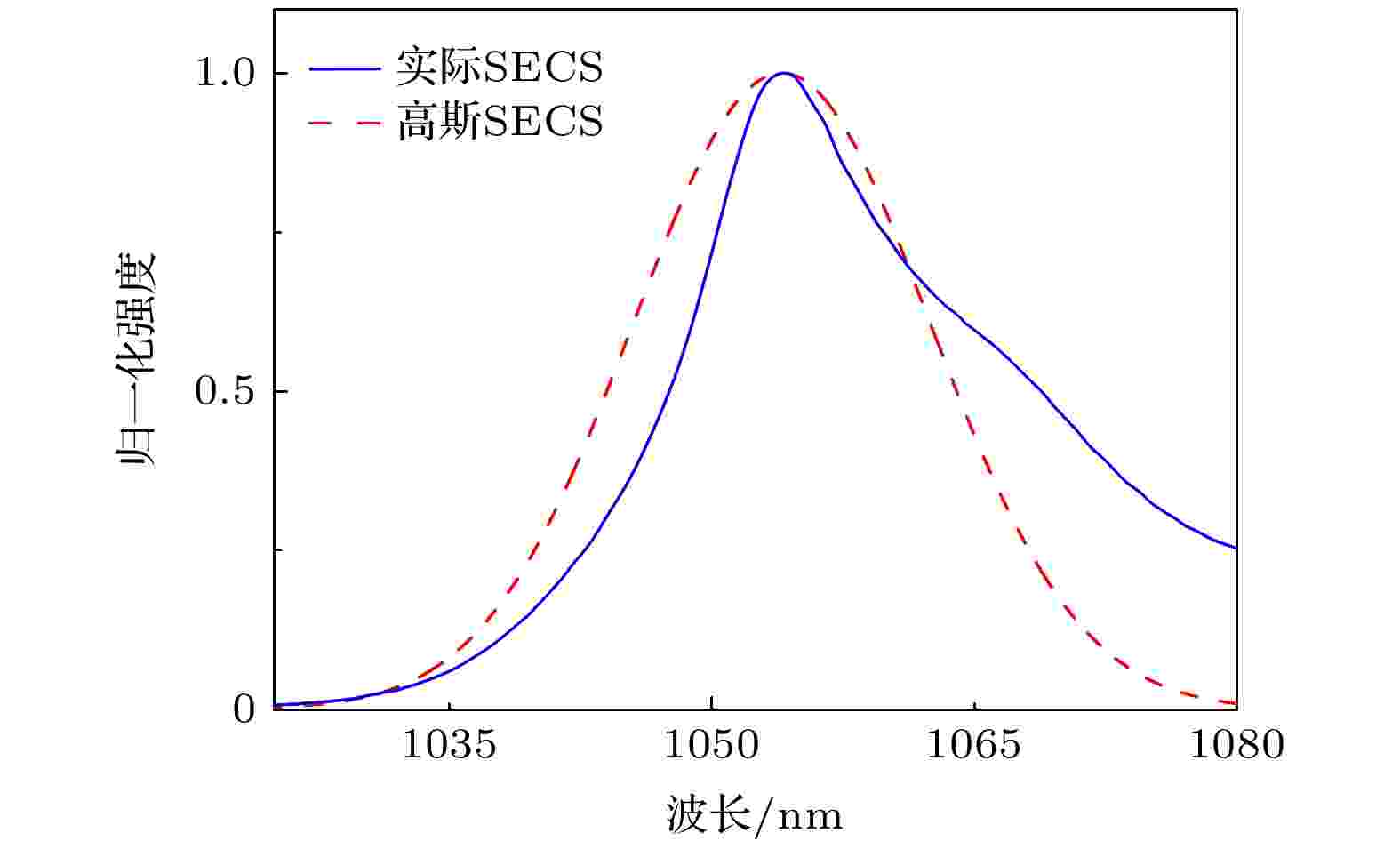 图 1 国内N31型磷酸盐钕玻璃实际SECS和高斯近似SECS对比
图 1 国内N31型磷酸盐钕玻璃实际SECS和高斯近似SECS对比Figure1. The compared SECSs between real N31 glass and Gaussian approximation.
在利用高斯SECS分析增益窄化等物理过程时, (1)式—(4)式存在解析解, 便于研究宽频带放大过程的物理规律, 但与实际SECS相比, 会存在差异. 为此, 首先我们校核了数值程序的准确性. 对于高斯型光谱注入(图2(a))和高斯SECS的情况[20], 在小信号增益下, 输出光谱宽度可以用公式





 图 2 小信号增益下, 10 nm (FWHM)高斯型光谱注入时, 不同SECS下增益窄化分析结果的对比 (a) 10 nm (FWHM)高斯光谱注入; (b) 高斯SECS和实际SECS下光谱窄化分析结果对比
图 2 小信号增益下, 10 nm (FWHM)高斯型光谱注入时, 不同SECS下增益窄化分析结果的对比 (a) 10 nm (FWHM)高斯光谱注入; (b) 高斯SECS和实际SECS下光谱窄化分析结果对比Figure2. In small-signal-gain regime and input of 10 nm (FWHM) Gaussian spectrum, the compared results of gain narrowing by different SECSs: (a) Input of 10 nm(FWHM) Gaussian spectrum; (b) the results of gain narrowing by Gaussian SECS and real SECS.
激光系统的种子采用光参量啁啾脉冲放大技术, 主要参数为: 中心波长1054 nm, 带宽10 nm (FWHM), 脉宽5 ns, 输出能量50 mJ (RMS < 3%), 光谱(脉冲)形状为超高斯(n = 5)分布, 在理论分析中将采用上述主要参数作为宽频带激光放大的注入条件.
针对宽频带激光系统, 利用(1)式—(5)式, 对比研究采用实际SECS 和高斯SECS对宽频带放大光谱特性的影响.
2
3.1.小信号近似下, 不同SECS增益窄化对放大激光谱宽的影响
首先分析了不同SECS作用时, 增益窄化效应对输出光谱宽度的影响, 注入光谱如图3(a)所示, 输出结果如图3(b)所示. 由图3可以看出, 当增益为107时, 宽频带放大输出的光谱宽度分别为5 nm (对应约350 fs压缩极限脉宽)和3 nm(对应约500 fs压缩极限脉宽). 实际SECS明显地加剧了增益窄化效应.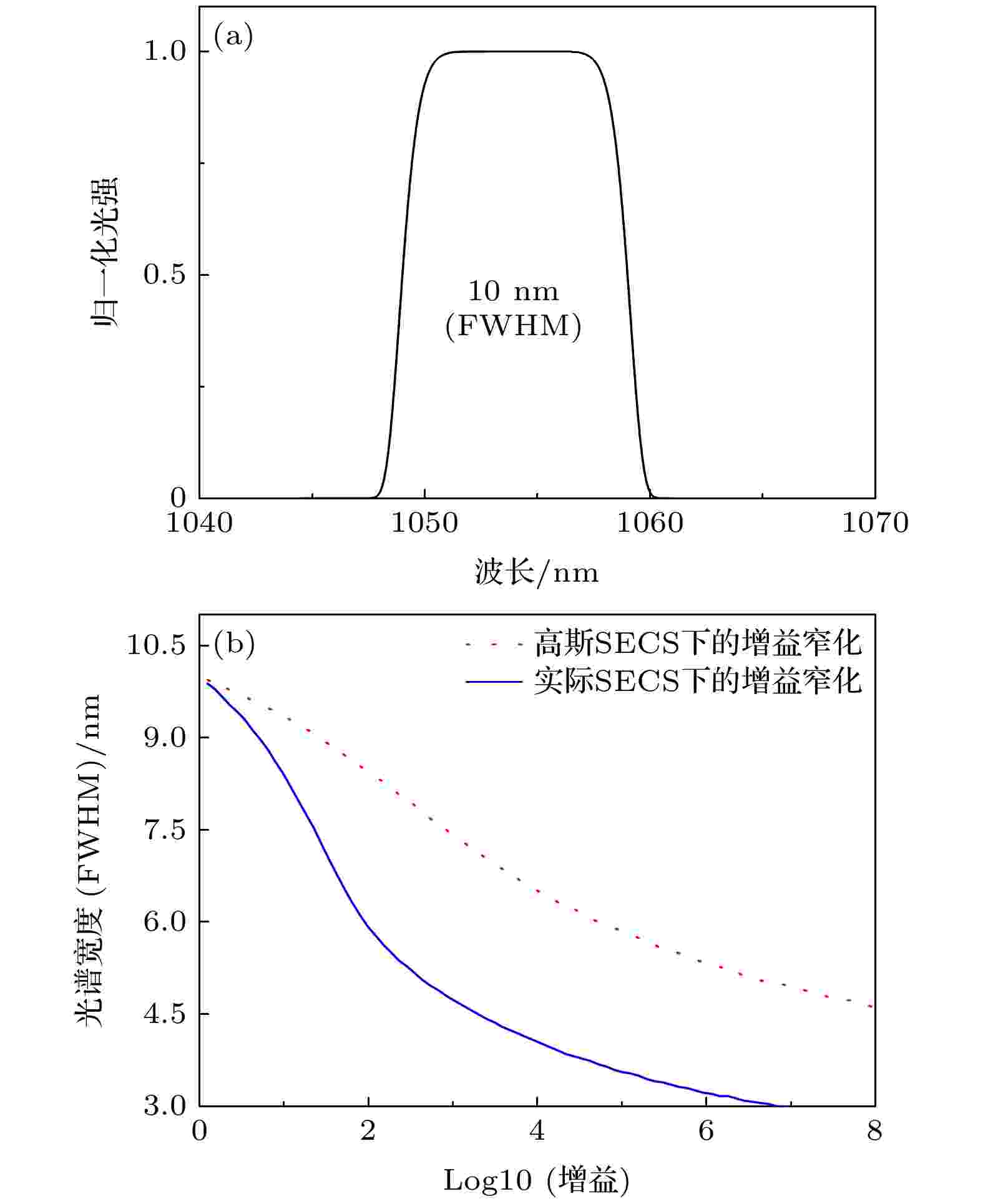 图 3 采用不同SECS时, 增益窄化对输出光谱宽度影响的对比分析 (a) 10 nm(FWHM), 5阶超高斯注入光谱; (b)采用高斯SECS和实际SECS时, 光谱窄化分析结果对比
图 3 采用不同SECS时, 增益窄化对输出光谱宽度影响的对比分析 (a) 10 nm(FWHM), 5阶超高斯注入光谱; (b)采用高斯SECS和实际SECS时, 光谱窄化分析结果对比Figure3. The influence results of gain narrowing to spectrum bandwidth by different SECSs: (a) Input of 10 nm (FWHM), 5-order super-Gaussian spectrum; (b) the compared gain narrowing results between Gaussian SECS and real SECS.
2
3.2.增益饱和下, 不同SECS对放大光谱形状、中心波长、谱宽和能量的影响
在宽频带激光放大过程中, 为了获得高的能量提取效率, 提高输出稳定性, 激光放大需要进入饱和放大区域, 伴随的增益饱和效应会导致脉冲时间前沿消耗更多的上能级粒子数, 由此对脉冲时间波形和光谱形状同时产生作用, 进而影响宽频带激光的放大特性. 下面, 对比在增益饱和情况下, 不同SECS对放大光谱形状、中心波长、谱宽、上能级粒子数变化和输出能量的影响.当宽频带激光注入能量为1.2 mJ 时(放大链路棒放和片放全部开启, 对应系统输出约2 kJ), 分别分析了棒放输出(图4(a)和图4(b))和片放输出位置(图4(c)和图4(d))的放大光谱形状及上能级粒子数变化情况, 结果如图4所示. 从图4可以看出: 1) 棒放输出位置, 从上能级粒子数变化的趋势来看, 此时饱和效应不明显, 属于高增益放大阶段, 由此带来的光谱中心红移较小; 2) 片放输出位置, 从粒子数变化来看, 饱和效应的影响增强, 对于高斯SECS, 光谱中心红移至1055.5 nm, 而对于实际SECS, 其中心波长为1054.2 nm, 中心波长并未发生明显红移, 这主要是由实际SECS(图1所示)非对称结构和饱和效应共同决定的.
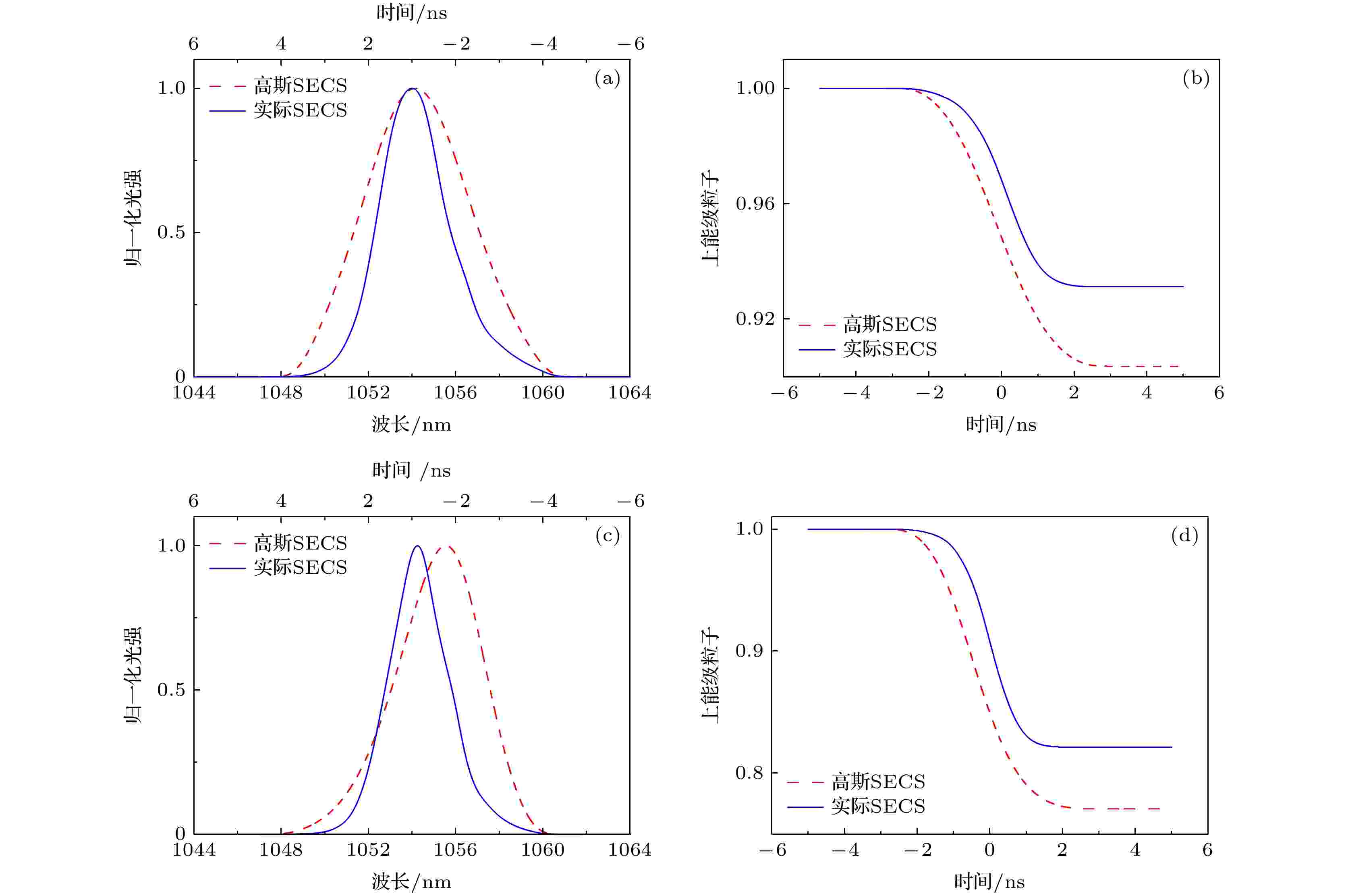 图 4 不同SECS 下, 棒放(a), (b)和片放(c), (d)输出光谱形状及上能级粒子变化分析结果的对比
图 4 不同SECS 下, 棒放(a), (b)和片放(c), (d)输出光谱形状及上能级粒子变化分析结果的对比Figure4. The compared numerical results of spectrum and upper state population after 70 (a), (b) and 350 (c), (d) amplifier, which influenced by different SECSs.
从图4(d)还可以看出, 在宽带激光系统的输出能力方面, 对于高能拍瓦激光来说, 为了保障压缩脉冲的时间质量, 需要控制系统的累积B积分小于2, 这限制了拍瓦激光输出能量小于2 kJ. 但是, 从上能级粒子数变化趋势来看, 此时, 仍有较大的剩余储能, 这对系统累积B积分要求并不苛刻的宽带倍频等应用来说, 系统可支持更大的能量输出.
为了进一步定量比较不同SECS在不同位置的激光输出能量、光谱宽度、中心波长和系统累积B积分等, 对比了棒放和片放的数据, 结果如表1所列. 从表1可以看出, 在棒放后, 不同SECS下的放大输出光谱宽度变化主要由增益窄化导致, 对于约2 × 104(从1.2 mJ 放大至24 J) 的增益, 实际SECS下光谱窄化至3.6 nm, 而高斯SECS则窄化为6 nm, 这在图4(b)中也有所体现; 对于片放, 实际SECS中心波长仍为1054.2 nm (谱宽3.1 nm), 而高斯SECS中心波长则从1054 nm红移到1055.5 nm (谱宽4.5 nm). 此外, 对于实际SECS, 由于光谱窄化严重, 导致相同能量水平下的系统累积B积分偏大, 在末级输出达到1.7 (对应能量1957 J), 而高斯为1.57 (对应能量2369 J). 由此可以看出, 采用高斯SECS会高估装置输出能量、输出光谱宽度和增益饱和效应带来的中心波长红移, 低估系统累积B积分, 进而导致与实际情况存在差异.
| 位置 | 激光参数 | 实际SECS | 高斯SECS |
| 棒放 | 能量/J | 24.43 | 34.23 |
| 光谱谱宽/nm | 3.6 | 6 | |
| 中心波长/nm | 1054 | 1054.5 | |
| ∑B | 0.24 | 0.22 | |
| 片放 | 能量/J | 1957 | 2369 |
| 光谱宽度/nm | 3.1 | 4.5 | |
| 中心波长/nm | 1054.2 | 1055.5 | |
| ∑B | 1.7 | 1.57 |
表1注入1.2 mJ, 5 ns, 10 nm宽带种子, 不同SECS下, 棒放和片放输出位置主要参数分析结果对比.
Table1.Input a 1.2 mJ, 5 ns, 10 nm broadband seed, and the main simulation parameters after bar and disk amplifier, which influenced by different SECSs.
2
3.3.不同SECS下, 注入中心波长偏移和能量抖动对装置性能的影响
首先, 分析了注入宽带种子中心波长分别为1052 nm (黑实线), 1054 nm (红点线)和1056 nm (绿短线), 如图5(a)所示, 采用高斯SECS和实际SECS分析时, 片放位置输出光谱特性的对比结果, 分别如图5(b)和图5(c)所示, 其他参数与图4(c)相同. 从图5(a)可以看出: 在SECS的有效区域内, 注入种子中心波长的变化并不会严重影响输出光谱特性, 只会导致光谱前后沿略有起伏. 而且, 由于实际SECS下的光谱窄化更严重, 使得有效放大的光谱范围更小, 这进一步地降低了对注入光谱中心波长的要求.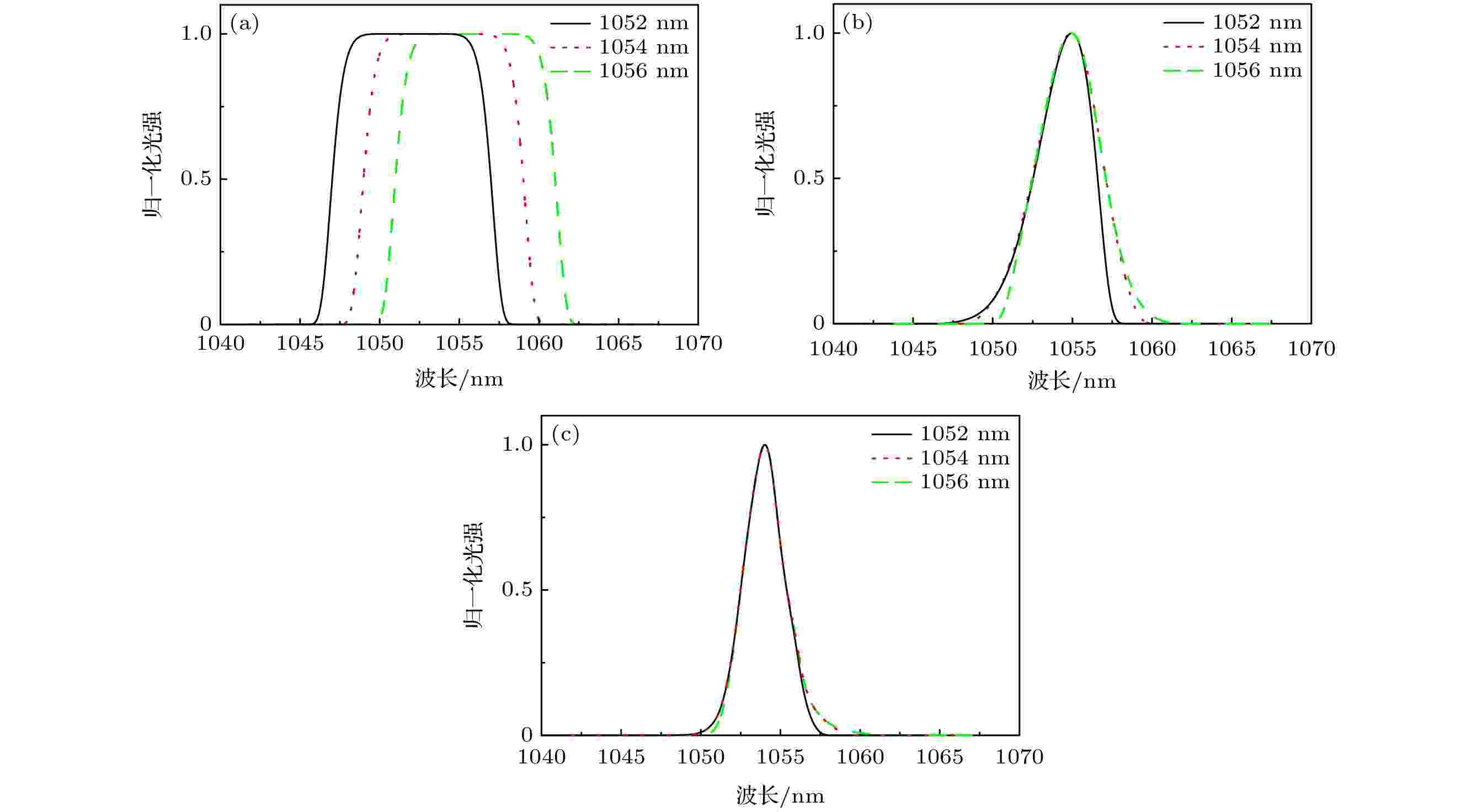 图 5 不同SECS下, 注入种子中心波长变化对放大光谱特性的影响, 其他参数与图4(c)相同 (a) 不同中心波长的注入光谱; (b) 高斯SECS下的放大光谱; (c) 实际SECS下的放大光谱
图 5 不同SECS下, 注入种子中心波长变化对放大光谱特性的影响, 其他参数与图4(c)相同 (a) 不同中心波长的注入光谱; (b) 高斯SECS下的放大光谱; (c) 实际SECS下的放大光谱Figure5. The influences of different inputted center wavelength spectrums to amplified spectrum by different SECSs: (a) Input spectrums of different center wavelength; the amplified spectrums by Gaussian SECS (b) and real SECS (c).
其次, 分析了不同SECS下, 宽频带放大输出能量抖动与输入能量抖动性的关系. 选取注入能量抖动(相对1.2 mJ, ± 10%)与输出能量抖动的关系如图6所示, 其他参数与图4(c)相同. 从图6可以看出: 当输入能量抖动在 ± 10%变化时, 输出抖动在 ± 6%以内, 而且高斯SECS分析结果稳定性优于实际SECS情况, 这主要是由于增益饱和效应带来的好处, 饱和程度越大(如图4(d)), 输出稳定性越好; 进一步地, 由于皮秒拍瓦宽频带激光系统要求累积B积分小于2, 直接限制了2 kJ输出能量和进入饱和放大区域的程度, 此时输出的能量稳定性只能依靠注入宽带种子源的稳定性来保障, 对于目前预放注入为3% (RMS)的稳定性来说, 理论上输出能量稳定性可以控制在2% (RMS)以内.
 图 6 不同SECS 下, 宽频带激光放大输出和输入能量抖动性的分析曲线对比
图 6 不同SECS 下, 宽频带激光放大输出和输入能量抖动性的分析曲线对比Figure6. The simulation relationship between input and output energy jitter by different SECSs.
 图 7 神光Ⅱ拍瓦激光系统宽频带激光传输放大示意图
图 7 神光Ⅱ拍瓦激光系统宽频带激光传输放大示意图Figure7. Block diagram of SG II PW laser amplification chain.
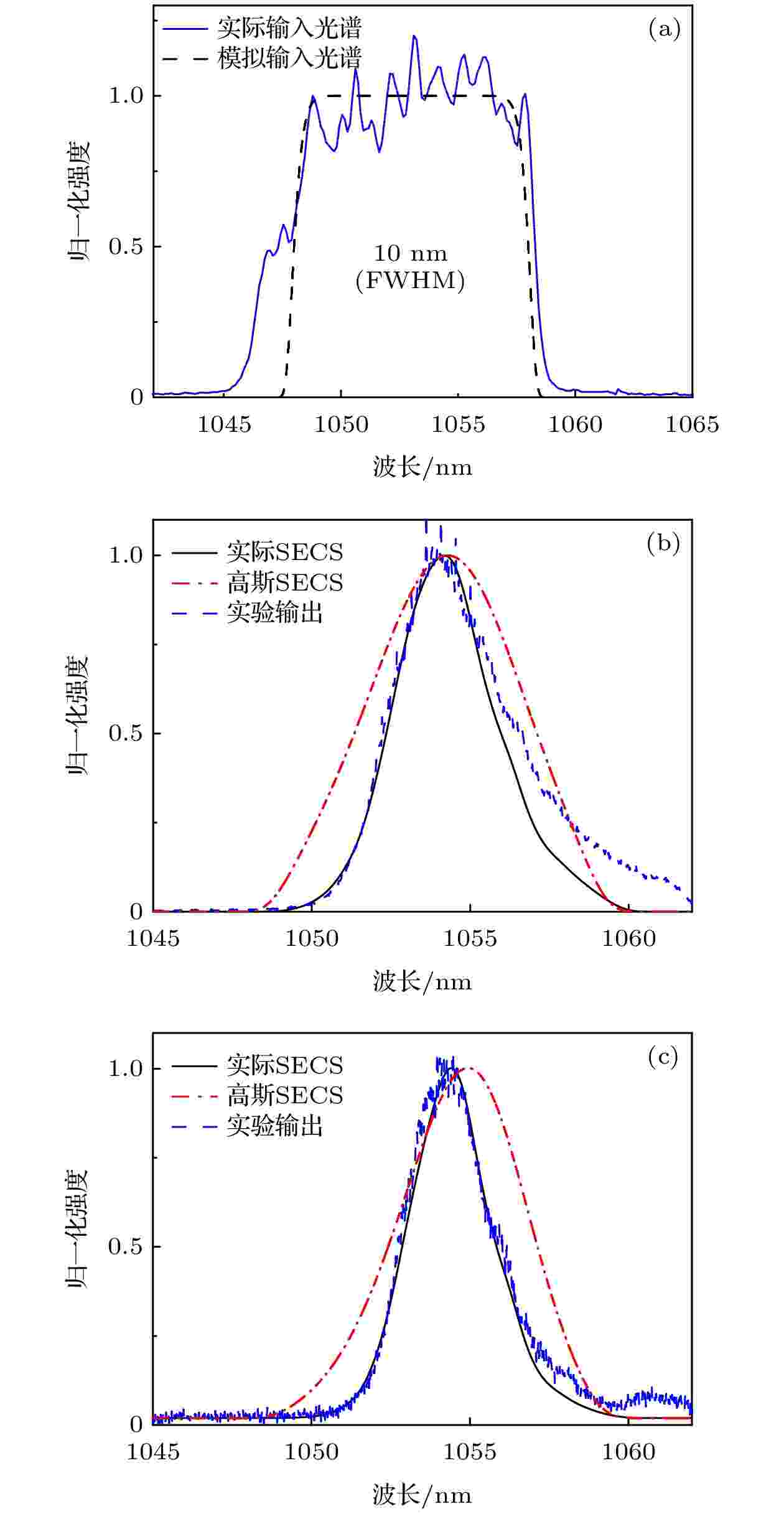 图 8 10 nm(FWHM), 5阶超高斯光谱注入, 输出1866 J时, 棒放和片放位置的实验数据与图4理论分析结果的对比 (a) 输入光谱实验及拟合数据; 棒放(b)和片放(c)位置光谱对比
图 8 10 nm(FWHM), 5阶超高斯光谱注入, 输出1866 J时, 棒放和片放位置的实验数据与图4理论分析结果的对比 (a) 输入光谱实验及拟合数据; 棒放(b)和片放(c)位置光谱对比Figure8. The compared results between experiment and simulation results after bar and disk amplifiers: (a) The compared input spectrums of experiment and simulation; the compared spectrum results after rob amplifier (b) and disk amplifier (c).
| 参数 | 发次1 | 发次2 | 发次3 | 发次4 |
| 实际输出/J | 1482 | 1642 | 1711 | 1866 |
| 光谱宽度/nm | 3.1 | 3.2 | 3.0 | 3.0 |
| 中心波长/nm | 1054 | 1054 | 1054.1 | 1054.2 |
| 预估能量/J | 1500 | 1650 | 1700 | 1900 |
| 偏差/% | 1.2 | 0.5 | 0.6 | 1.8 |
表2利用神光II高能拍瓦宽频带激光系统得到的实验数据.
Table2.The experiment results of amplified broadband laser by using SG II PW laser amplification chain.
进一步地, 测量了1866 J能量下, 棒放和片放输出的光谱形状, 与图4(a)和图4(c)的理论分析对比, 结果分别如图8(b)和8(c)所示. 从图8(b)和图8(c)可以看出, 利用实际SECS的理论分析结果和实验数据符合较好, 实际SECS可以更为准确地分析宽频带激光放大的光谱特性, 而采用高斯SECS在判断输出光谱带宽和中心波长红移等问题时会存在较大差异.
